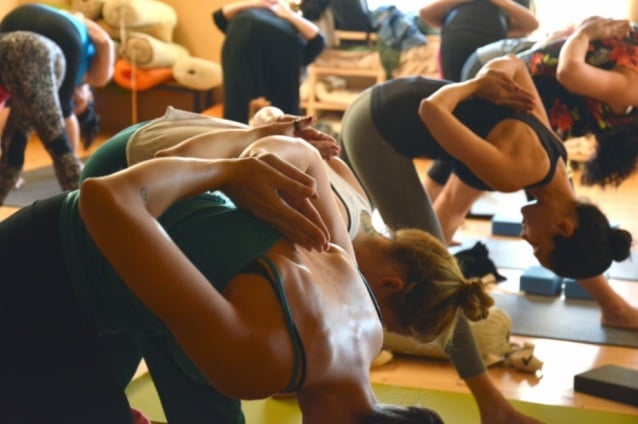
About 10 years ago, I was living in Buffalo, New York for a short stint, and found myself in a crowded yoga class.
There were maybe 25 or 30 sweaty bodies in a small attic-like space, rushing to keep up with the acrobatic sequences the young teacher was pushing us through.
I wasn’t new to yoga—I’d been practicing for a few years by then—but I felt completely disoriented and confused by the complex poses we were expected to cruise through, and I remember thinking, I can’t wait until this is over so I can sit down and relax with a beer somewhere.
If that sounds funny to you, here’s why: yoga practice shouldn’t be stressful, and it shouldn’t drive you to drink.
My impression, coming away from that class, was that I’d just survived some teacher’s manic episode writ large on a group of yoga hostages. I felt grateful for having had more conscientious teachers in the past who taught well-paced classes that really drew you into your practice and made you feel good.
Since that time, I’ve been practicing in various studios across the Front Range, and have become super turned off by the fast-paced “breath to movement” vinyasa classes that are curiously popular here. I don’t think this kind of yoga is what students need or even want, really; I think it’s simply what yogis in this region have come to expect because that’s largely what’s being offered.
Some reader out there is thinking, Hey, I love my fast vinyasa class! What’s your problem? So, let me explain what I think is problematic about teaching and practicing this style:
1) it makes for sloppy yoga;
2) it robs the student of the opportunity to truly experience any one yoga pose; and
3) it forces the student to rush through the practice, which is inherently stressful and thus counterproductive to a fundamental aim of yoga—to achieve calm in body and mind.
In essence, it embodies a terrible message that all of life has to be fast-paced and high-pressure—even yoga.
It makes sense, in some parts of the practice, to guide students in coordinating movement to breath (as opposed to “breath to movement;” breath should be primary). For example, raising arms up over head invites an inhale—it feels natural to the body, as does exhaling while lowering the arms. Inhaling to steady the gaze and exhaling to come into a balance pose, such as natarajasana (dancer’s pose), is also appropriate and feels natural to the body and mind. Holding the pose then for several breaths allows the student to build muscle memory and experience the benefits of the pose.
Poses requiring more complicated transitions, however, should never, in my opinion, be included in a “breath to movement” fast vinyasa flow.
A common example is the transition from virabhadrasana I (warrior I) on an inhale to virabhadrasana II (warrior II) on the exhale. These poses have different foot placements, different hip orientations, and different arm positions. Who can do all that effectively in two breaths…? And you’d never want to take students, for example, into utthita trikonasana (triangle pose) in one breath, and parivritta trikonasana (reverse triangle pose) in the next because there’s way too much going on in that transition to do it well in just two breaths.
If you’re a teacher and thinking, No one would teach that, yes, someone did—in a class I was in recently.
Perhaps the worst is when balance poses, such as virabhadrasana III (warrior III) or ardha chandrasana (half moon pose) are thrown into a fast-paced flow: yuck!
To direct students to move from one complex pose to another at a fast breath pace is simply asking for sloppy poses, poor alignment, and no real learning or insight on the students’ part. If students don’t have enough time to even set up the pose properly before being cued to move on, how can they allow for opening in the body, new neural pathways in the brain, and feelings of confidence and willpower?
The second reason why this style of yoga is problematic is even deeper.
Modern life forces us to rush through our lives. We rush to get to the work in the morning, and we rush home in the evening. We rush down the highway back to our homes. We rush through tasks and errands we don’t enjoy. We rush through obligatory social engagements we don’t feel like being at. We rush through our half hour lunch break. So, why in the world would we want to make our yoga students rush through the one hour of their day, or even week, which they set aside for a mindfulness practice?
Someone is thinking, Well, just because the yoga teacher directs a fast-paced flow, it doesn’t mean I have to do it; I can take my time, or even sit it out. Good for you. But trust me, not everyone realizes this. I’ve been teaching yoga in Boulder County since 2009, and it’s common for students to do or try to do everything you cue, even when you offer all the disclaimers: listen to your body, everything I cue is just a suggestion, you can opt out of any pose, or my personal favorite, the more you practice yoga, the less you listen to the teacher.
But all of these healthy suggestions of independence and autonomy in one’s practice can take years to germinate. Most students are eager to follow along and keep apace with the teacher and the other students.
So the onus is on the yoga teacher, and my question is this: why do we teach this style of yoga? Is it helpful to our students? Is it serving a need for more mindfulness in their yoga practice and in their lives? People are often drawn to what’s familiar, what they’re used to, rather than what they truly need or would benefit from. In the Front Range, we live in a bubble of extreme sports, extreme fitness, extreme weather, extreme wealth, and extreme politics.
Can we give ourselves and our students a break from all that when we come together to practice? Yoga doesn’t need to be extreme.
We talk a lot about taking our yoga “off the mat.” What this means is that by practicing strength, flexibility, balance, and humility on our mats, we’re more likely to manifest these principles in other aspects of our lives. Do we want to engender a practice of doing things sloppily and quickly just to get them over with? I don’t think so.
Let’s slow it down, take a few breaths…and take our time to do it well and experience it fully.
~
Author: Liz Swan
Image: PxHere
Editor: Catherine Monkman
Copy & Social Editor: Travis May






Read 5 comments and reply